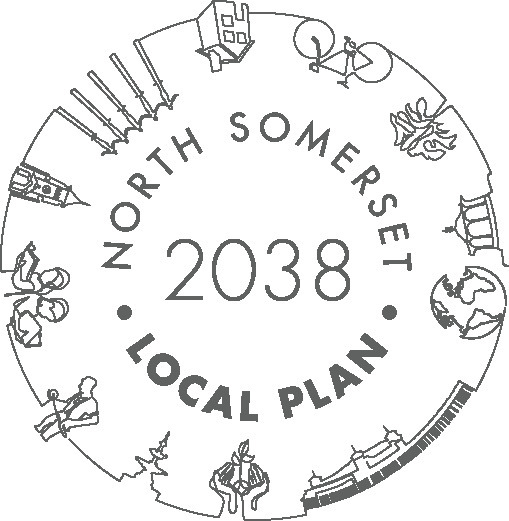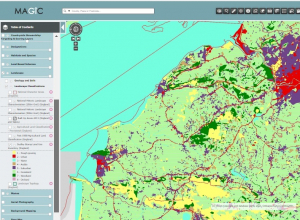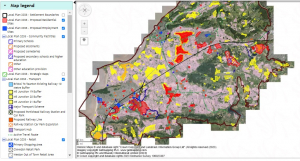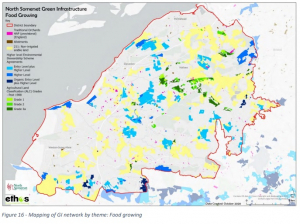
WHERE IS ALL THE AGRICULTURE LAND GOING... GOING... GONE?
Public consultation coming soon ... end of October 2023?
Not all farmers are land owners. Those that are not land owers depend on their landlords to continually extend their leases, so that they can continue to farm. The actual land owners could live in the community, another part of the country, even abroad, using the land for investment purposes (e.g. in 2018 Bristol Airport was majority owned by Ontario Teachers’ Pension Plan Canada!)
See related Biodiversity Net Gain Consultation BOB Blog and
Draft Rural Strategy Considerations
New Local Plan Consultation 28 Nov 23 (NSC)
Is it North Somerset Council's intention to destroy farming in the district, or is this just an 'error' between different departments? If it is their intention, why not openly and publicly state this in consultations and public information? [NOTE 2]
What is North Somerset Council's plan for agriculture, food production and food security? Where is its Rural Strategy and/or Food Security Plans published? See the live NSC Local Plan discussion and the draft consultation, that went for approval 18OCT23. On a positive note - Some previous feedback has been taken into consideration with regards draft DP7 solar proposal as seen amended here- so it's worth continuing to submit your feedback on these policies, especially if you wish to continue to support local meat, dairy, fruit, veg, beer and wine produce. (Mendip Times Food & Drink Golden Triangle OCT23)
North Somerset is already covered with 'green' agriculture land | NSC plan to cover fields with solar panels and developments? Where is the food mapping?
| NSC map shows fields in use for food production... so why destroy local food production? |
Draft pg 87 extract "Policy DP7: Large scale renewable and low carbon renewable energy... Proposals for energy generation from renewable and low carbon sources including wind turbines, solar photovoltaic arrays, biomass and hydropower (marine, river and tidal) schemes will be supported subject to no unacceptable impact on... NO MENTION in relation to FARMING OR FOOD PRODUCTION???:"
CPRE The problem with solar farms - the factors that should be considered in determining applications (2021)
See also DP53 Best & Most versitile land in Draft pg 181 "The proportion of Grade 1 land in North Somerset is approximately 7% and 10% for Grade 2. 60% falls in Grade 3..." How much of this land is already in use as food production for people and animals? How much land will be lost if NSC's Local Plan above and associated Biodiversity plans happen?
As to areas outside those identified in the Local Plan, i.e. coloured pink, yellow, orange, red, etc. "When assessing proposals for development on unallocated sites on agricultural land its agricultural land classification (ALC) will be taken into account. Where the land classification is uncertain or classified as grade 3 without further subdivision, a full survey will be required to establish its quality. The best and most versatile (BMV) land (grades 1, 2 and 3a) will be protected from significant, inappropriate and unsustainable proposals as follows..." [Note 1] The DEFRA Post 1988 Agricultural Land Classification mapping used by NSC via DEFRA doesn't seem to recognise existing local farming when compared to the Dudley Stamp map?
| ||
Gloucestershire "County at risk of becoming ‘Solarshire’ due to number of photovoltaic panels planned... if they are all approved it could create a corridor of one million solar panels... The new Local Plan, which is currently being developed, will set out the guidelines for development across the district until 2041, once adopted." (25OCT23)
NSC Renewable and low carbon energy generation webpage, Where is the farming, food production and food security asessed if the land is removed in any way for solar and wind technologies
- Solar Photovoltaic (PV) Arrays (2013.)
- "3.4 We are not likely to support applications on the highest graded agricultural land (grades 1 or 2) and strongly encourage prospective developments towards the lowest graded land." NB 17% is Grade 1 & 2, 60% is Grade 3 within NSC.
- ""3.19 Creating habitats rich in wildflowers with apiculture as part of the permanent management plan (to increase bee numbers to the benefit of surrounding farmlands)." How is NSC protecting existing food production and food security? How is it ensuring that the 'surrounding farmlands' are surviving and not being encouraged to diversify, or close due to a lack of available tenancies or appropriate grade or sized farmland?
- "4.6 Solar PV facilities that are developed on agricultural ground must be ‘reversible’ allowing the site to be easily restored to agriculture. Hence intrusive groundworks, such as trenching and foundations should be minimised and the use of concrete avoided where possible. Frames should be pile driven or screw anchored and not concrete-based, and capable of easy removal, allowing the ground to be fully restored. In windy areas the stability of the installation will need to be considered."
- "4.14 In most instances the ground beneath solar panels is capable of remaining in agricultural use. Existing pasture cover should be maintained, whilst if the land is currently arable, applicants are advised to grass-seed the site. The land will require management, and the preferred option is that sheep grazing or similar should be enabled. If the grass is to be mown, then the potential for habitat gain, through wildflowerseeding, should be considered"
- Regen SW assessment potential areas for large scale wind turbines
- Bleadon Levels
- Resource assessment for wind and solar in North Somerset and opportunities to support the wider sustainable energy sector (2013)
- "Agricultural land grades 1 and 2 excluded Grades 1 and 2 are the best and most versatile for food production."
The UK government states, "... food security means strong and consistent domestic production of food combined with a diversity of supply sources that avoids overreliance on any one source... Home-grown produce is the largest source of food for the UK... In meat, milk, and eggs, the UK produces roughly equivalent volume to what it consumes. In 2020 it produced 61kg of meat, 227L of milk and 172 eggs per person per year ... The UK produces a significant proportion of its other crop needs, including around 60% of sugar beet, 70% of potatoes and 80% of oilseeds... The UK produces over 50% of vegetables consumed domestically, but only 16% of fruit." (05OCT23).
In order to be food secure, it appears that the UK cannot afford to lose any agriculture land and indeed needs to increase vegetable and fruit production.
The govt Food Security 2.4 "Food security is one of the thirteen sectors listed in the Government’s “Critical National Infrastructure” (CNI) document: CNI are “necessary for a country to function and upon which daily life depends”. [NOTE 2] (28JUL23)
Bleadon is calling a public meeting re: local plan and resident concerns, come along before putting in a response to consultation.
Previous Local Plan Consultation information
----
See also:
- NSC Corporate Plan Consultation closed on 16 Oct 23, yet there was no mention of farming. However, it did note on p14,
- “Quality and affordable new homes will be being built on the council’s own land with infrastructure projects underway to unlock further delivery.” Is NSC selling off farmland? How much has it sold over the last 5-10 years? How does this help future generaƟons of agriculture within North Somerset, and young peoples’ career choices? How does this fit with any ‘duties’ for local food production and delivery nationally? How does this fit with NSC Local Plan re: solar, wind, housing and road network development in general?"
- NSC Biodiversity Consultation (Blog)
- NSC Rural Strategy (to come?)
- NSC Green Infrastructure Plan (BOB Blog)
- NSC Empowering Communities Strategy v2 and Action Plan LR (PDF)
- NSC Joint Health and Wellbeing Strategy HWBS action plan (PDF)
- NSC Local Plan Consultation (Blog)
The draft consultation, that went for approval 18OCT23, states,
- Draft pg 198 onwards, indicate that many farm addresses are listed for development.
- "Proposals for wind turbines and solar photovoltaic arrays will be supported in principle within the Search Areas shown … and the proposed site is not within (land) grades 1, 2 or 3a" (05FEB21))
- Draft pg 184 states, "Farmers are encouraged to diversify their activities and supplement their income from enterprises other than normal food production."
- Draft pg 186 states, "Planning permission will be granted... provided that... In the case of diversification proposals, there is sufficient certainty of long term benefit to the farm business as an agricultural operation... Farm diversification activities can contribute to the local economy by providing opportunities for employment or recreation for residents and visitors and by resulting in increased patronage for local shops and services."
- Draft pg 190 states, "The conversion or re-use of rural buildings will be permitted providing that... It would not have a significant adverse effect on the living conditions of adjoining occupiers or adversely affect the operation of working farms... Retailing will not be permitted, other than farm shops, small scale village stores, proposals under 200m2 square metres or proposals that are ancillary to the main use. If the building was completed within 10 years of the application being submitted for an agricultural or equestrian use the applicant will need to demonstrate that the conversion of this building is essential for the long-term benefit of the associated agricultural/ forestry/equestrian operation "
- Draft pg 195 states, "Proposals for new or extended touring and static caravan outside the Green Belt and AONB will be permitted provided that... All visitor accommodation should: • Not have a significant adverse effect on the living conditions of adjoining occupiers or adversely affect the operation of working farms"
- 10 National Protective Security Agency, Critical National Infrastructure, accessed on 11 July 2023
- "Critical National Infrastructure National Infrastructure are those facilities, systems, sites, information, people, networks and processes, necessary for a country to function and upon which daily life depends. It also includes some functions, sites and organisations which are not critical to the maintenance of essential services, but which need protection due to the potential danger to the public (civil nuclear and chemical sites for example)... there are 13 national infrastructure sectors:... Food... Water"
- 11 Defra is the lead Government department on food supply [PQ51874 28 September 2021] (PDF), although the UKFSR states that “the role of government is an indirect one; to plan for and coordinate responses and intervene only where necessary to ensure the continuity of supply” given that the “underlying infrastructure of the supply chain is owned and operated by private industry” [Defra, United Kingdom Food Security Report 2021: Theme 3: Food Supply Chain Resilience, updated 22 December 2021 - 05OCT23] So how is NSC food security addressed in its Local Plan?






Make A Comment
Comments (0)